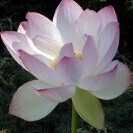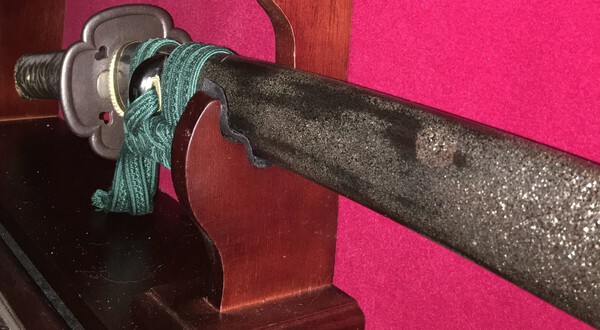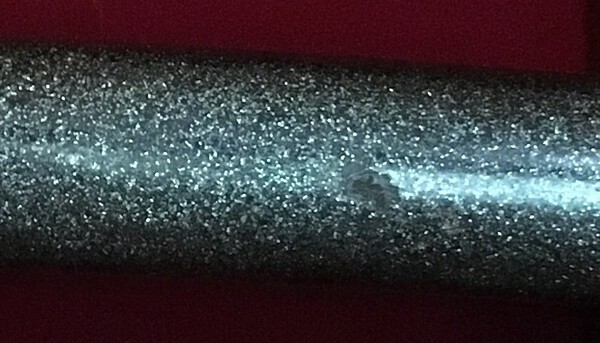-
Posts
732 -
Joined
-
Days Won
1
Content Type
Profiles
Forums
Events
Store
Downloads
Gallery
Everything posted by Franco D
-

How to remove green corrosion?
Franco D replied to Yumso's topic in General Nihonto Related Discussion
The problem here is oiling and toothbrushing while possibly removing some of the verdigris may not solve the problem nor achieve the result desired. The kashira shows signs (at least to me) of having been exposed and damaged by something chemically corrosive. It needs more attention than simple cleaning, like professional help. The shitadome on the kashira look embedded with verdigris. Proper cleaning will require removing them for cleaning. Unless all of the green is removed and properly treated there will be a good chance that over time it will come back. Getting oil and/or water on and soaked into the ito during the cleaning process may only make the problems become worse. While the fuchi/kashira may be Nara school fittings, the damaged kashira may bring the effort to save them into question. Since the fuchi is apart it can be cleaned. I would begin by using a soft wooden toothpick to very gently scrape and loosen the verdigris. Then, using a soft cotton Q-tip dipped in anti-hydrous isopropyl alcohol wipe away the loosened verdigris. Repeat that process until gone. The, once you're convinced the surface is clean, again, using a soft tipped Q-tip apply a thin film of good neutral light sword oil. It is always wise to do a test spot somewhere inconspicuous to be sure what you're applying is safe and is not doing any harm. p.s. change soiled Q-tips, do not reuse once soiled. On a personal note, it looks to me as if this entire tsuka and wrap needs to be redone. Regards -

How to remove green corrosion?
Franco D replied to Yumso's topic in General Nihonto Related Discussion
No! Vinegar is acidic and that should definitely not be used. Because these are mounted fittings I would consult with a professional first before attempting to clean these. Loose fittings are a different story. Regards -
Chu kissaki is sometimes described as being elongated. Based upon the image that appears to be the case here. Regards
-
Study, build a library, when he feels there is nothing more to learn from this sword, then, if he chooses, he can move on. Regards p.s. Although I did not really get to know him well before he died, Allan H. Pressley is where my path to learning nihonto began more than thirty years ago. Chicago was the first show I attended.
-
It appears that the new caretaker has some homework ahead of him. https://www.nihontoc.../Mihara_Nihonto.html Good first sword! Regards
-
The section of the saya I posted above comes from an old original saya that could date anywhere from the early part of 1700's onward. This saya/koshirae was most definitely used and even sports an old repair that is visible in the image above. In the image below the obi wear is clearly visible. The change in color is due to the lighting.
-
Yes, urushi lacquer. Don't recall anything else being mentioned.
-
-
Please forgive me Piers for posting additional pertinent information.
-
What exactly is that supposed to mean?
-
https://nihonto.com/12-1-23/ also; Hoki school/tradition, Yamanaka's Newsletters revised, page 248.
-
That is a definite possibility. If that is indeed the case, then it appears that the polisher did not reshape the entire kissaki as what should have been done. However, as Ray said, it does appear like some boshi remains. Regards
-

Wakizashi genuine signature/mei?
Franco D replied to VRGC's topic in General Nihonto Related Discussion
Prices cover a wide range starting from hundreds rising to tens of thousands. It all depends on age, rarity, quality (Juyo), style, and originality. For example; https://nihonto.com/...e/fittings/koshirae/ Regards -
That website does recycle articles over and over again, in addition to tracking the topics you favor. Still, that is a sword that one never grows tired of seeing again and again. Regards
-

Just inherited a Japanese Sword
Franco D replied to 25 yr Navy Vet's topic in Translation Assistance
Please do. Full image of entire sword, with close ups of the boshi (tip) and full nakago, for starters. Condolences for your Grandfather. Thank you. Regards -

Wakizashi genuine signature/mei?
Franco D replied to VRGC's topic in General Nihonto Related Discussion
Comments, Regardless of what the mei turns out to be this sword has a very pleasing shape, a sign of a good sword. It also has a suguha hamon which is another indication of a skilled swordsmith. As far as the mei goes, it is likely that the list of smiths signing "Kanda (no) Ju Kane 囗" is short and will appear in Hawley's (which I no longer have). Which gives a place to begin research. Regards -
https://books.google...#v=onepage&q&f=false https://books.google...html?id=52kyRMCGqB0C Markus to the rescue! Regards
-
Not sashikomi. Looks ubu, machi-okuri. No, this is shakudo. Looks copper because the patina is worn off.
-
The Japanese have a saying "bad swords hurt your eyes." That saying applies to fittings as well. My eyes are burning right now. The Japanese also advise to study and learn from the best nihonto. That advice applies to sword furniture, too. Quality is very poor; gold, shakudo. While the nankako itself isn't terrible, it is at best average. Agree, dragon is Goto style but similarity ends there, detail matters. Agree, this dragon looks to be a replacement for something else, composition is poor. There's no objective in liking. Regards Desire is the cause of suffering.
-
Now you can begin to appreciate what a professional fittings restorer has to go through. Regards
-

Wakizashi genuine signature/mei?
Franco D replied to VRGC's topic in General Nihonto Related Discussion
Hello Victor, Of course, when it comes to mei verification the answer is "shinsa." However, with some patience perhaps one of the good folks here will chime in with an opinion? Regards "The sword confirms the mei and not the other way around." p.s. The importance of a library when it comes to nihonto collecting cannot be overstated. As a collector your homework should have already been well on its way to researching the object of your desire, and I'm not talking about only the mei, before completing the sale. Of course the mei, that is, if the sword has one, is of importance. But more importantly is the research that says that yes indeed this sword is in fact what it purports to be. If kantei is the foundation of sword appreciation as the Japanese claim it to be, then it should also make up the foundation for our sword collecting as well. Collecting nihonto is an open book test! One should know the answer before completing the exam. -
Hello Tom, The best way for me to answer your questions is; First, have the sword fully assessed. Once assessed, then, comeback and ask for value opinions. Secondly, if mine, I would not have this sword restored even if it checks out to be restorable. The exception to that is if by some longshot this sword turns out to be something exceptional. In general, unless a piece is Tokubetsu Hozon level or better in form and or quality, restoration may not be a wise decision. https://nihontocraft...hinsa_Standards.html Regards
-
Hello, Kanbun Shinto is probably a pretty good bet as far as age goes based upon shape and other factors. Although there is a partial mei that could be used to help track down or at least narrow down the possibilities of who may have made this blade. At least for myself, there may be a more immediate issue that needs attention after looking at these images. The images of this blade at the kissaki end and also towards the habaki raises questions of possible heat exposure. If that is the case, it would render the sword itself a souvenir. Sometimes in such cases the fittings also demonstrate heat damage exposure, but the fittings look to be fine here. Fire damage to nihonto is not an uncommon problem. Hopefully that is not the case here. Regards
-

Wakizashi genuine signature/mei?
Franco D replied to VRGC's topic in General Nihonto Related Discussion
Hello Victor, The nakago should indeed not be cleaned! What I do in the case of red rust on the nakago. In the beginning, using only your (clean, dry) fingers apply a coating of sword oil onto the nakago allowing it soak in for about a minute or two. Then, using a soft clean absorbent chem free cloth blot (do not rub) the oil off, such that you're only leaving a very thin film of oil on the nakago denying the red rust access to oxygen and moisture. This process is to be repeated, using less and less oil, on a daily > then, semi-daily > then weekly basis until you can visibly see the red rust turn into black rust. Which is what you want. Any thicker or heavier rust will generally flake off in this process. In the end it should be barely visible/detectable that any oil remains. When in doubt ask! Regards,








